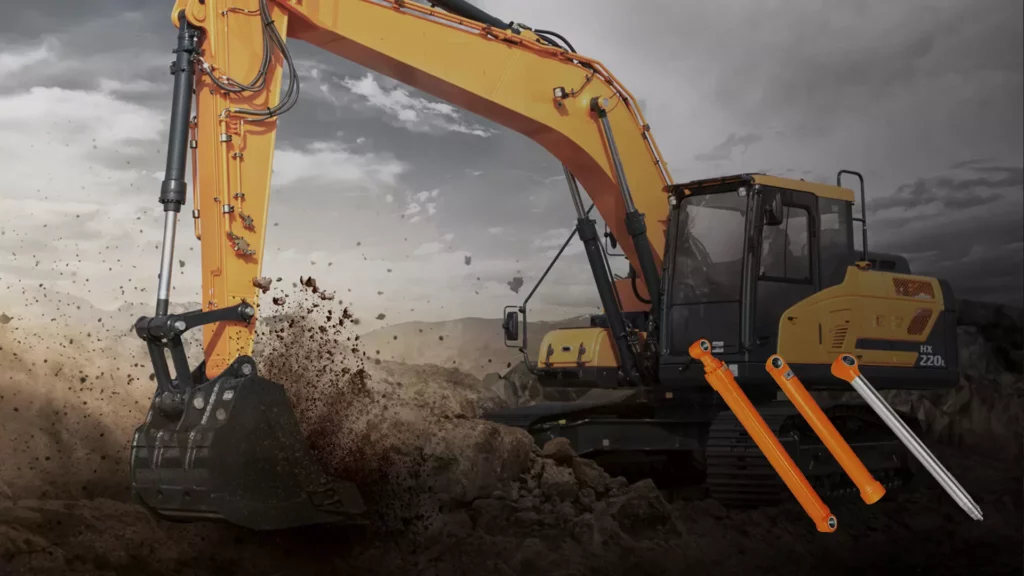There’s a lot of terminology and concepts to learn when it comes to excavator hydraulic cylinders. In diesem Artikel, we’ll explore the basics so you’ll have a better understanding of what’s happening under the hood. From excavator hydraulic cylinder factory, you may find there are many types of cylinders. Such as boom cylinder, arm cylinder and bucket cylinder.
What is an excavator hydraulic cylinder, How it work?
An excavator hydraulic cylinder is a hydraulic device that uses pressurized oil to create a piston-like effect. This piston-like effect is used to move the excavator arm up and down. A hydraulic cylinder is a device that uses a liquid to create a force that can move an object. The liquid is contained in a cylinder, and the object is attached to a piston. When the piston is moved, the liquid is forced through a small opening, called a port. This pressure creates a force that can move the object.
What are the different types of hydraulic cylinders?
There are three main types of hydraulic cylinders: single-acting, double-acting, and telescoping.
- Single-acting cylinders are the simplest type. They contain a single piston that moves in and out of the cylinder, and they only work in one direction.
- Double-acting cylinders have two pistons: one that moves in and out, and one that moves up and down. This type of cylinder can work in either direction.
- Telescoping cylinders are similar to double-acting cylinders, but they have a smaller piston that moves up and down inside a larger piston. This type of cylinder can be used to create a more compact design.

How do you choose the right hydraulic cylinder for your excavator
Around you, there are so many excavator hydraulic cylinder for sale, but which one is right to you? When you are looking for a hydraulic cylinder for your excavator, there are a few things you need to take into account. You need to make sure that the cylinder is the right size for your excavator, and that it is able to handle the weight of the excavator. You also need to make sure that the cylinder is able to withstand the pressure that will be put on it.
- The hydraulic pressure of the pump must be sufficient to provide sufficient pressure to act on the cylinder and lift the required load. If you can’t provide enough pressure, the size of your cylinder doesn’t matter.
- You need to know the approximate weight of the object you are lifting. The more accurate the better.
- Some elevators are simple single point elevators, but sometimes it is not feasible to balance the load with only one point, so two or more points are required.
The Fluctuation of Hydraulic Pressure Differentials of Boom, Arm, and Bucket on Excavators
Operators of excavators can adjust the boom, Arm, and bucket to control the amount of material they can move with each scoop. The hydraulic pressure differential between these components also affects how smoothly the excavator moves. Too much pressure in any one component (mini excavator hydraulic cylinder, multi stage hydraulic cylinder) can create an imbalance. And make the excavator difficult to control. The hydraulic pressure differential is one of the most important factors when it comes to excavators. This is because it helps to control the boom, Arm, und Eimer. It is important to maintain a consistent pressure differential in order to avoid any fluctuations that could potentially damage the equipment.
Hydraulic pressure differentials play a significant role in the excavation process
Differential hydraulic pressure is what helps to move soil and rock during excavation. This pressure is created by the difference in elevation between the points where the water is entering and leaving the excavation area. The higher the pressure, the more efficiently the soil can be moved.
The fluctuation of these pressure differentials can affect the movement and performance of the excavator
The excavation process involves the use of a large, specialized machine called an excavator. Normalerweise, this excavator with boom cylinder is used to remove earth and other materials in a controlled manner, in order to make way for construction or other projects.
The excavator relies on a number of factors in order to function properly. One of these is the pressure differential between the environment and the excavator itself. This differential can vary significantly. It will depend on a number of factors, including wind speed, barometric pressure, and the elevation of excavator. Zum Beispiel, if the pressure differential is too high, the excavator may experience difficulty in moving earth or other materials. Conversely, if the pressure differential is too low, the excavator may move too much earth or material, resulting in a safety hazard.
